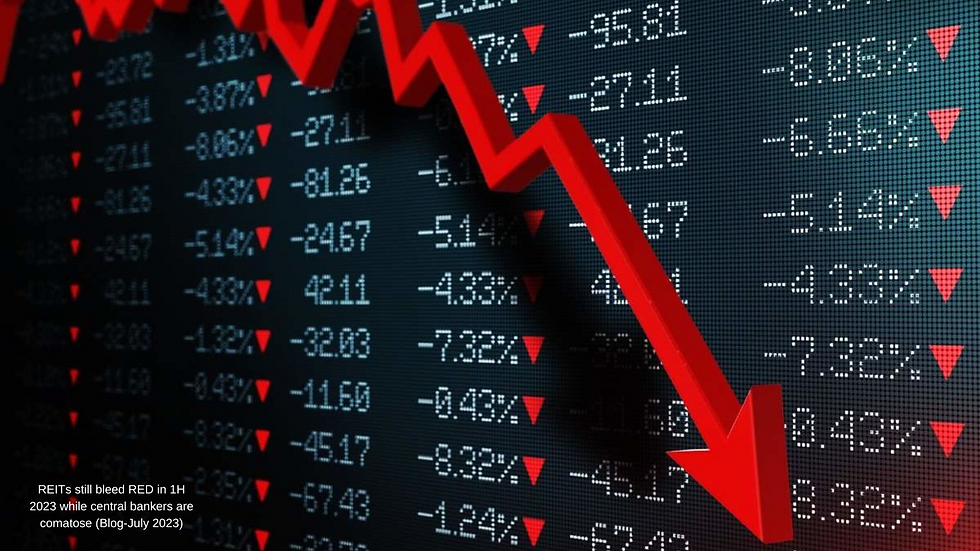SINGAPORE BANKS ARE NOT HEADED TOWARDS LEMONS OR LEHMAN REPRISE
- by Gabriel Yap

- Nov 18, 2017
- 4 min read
03/2016-
The first 2 months of 2016 witnessed one of the greatest market panic and despair I have ever since, since the Global Financial Crisis (GFC) in 2008. Not surprisingly, Singapore banks stocks have been sold to the dogs with valuations reached since the 15 Sep 2008 lows from the Lehman-triggered Global Financial Crisis.

The recent banks results for FY2015 announced in Feb 2016 have clearly dispelled investors’ fears of a Lehman-like banking crisis or that Singapore banks have become lemons. Indeed, the huge sell-offs have probably presented the best investment opportunity in the last 5 years.

Going into the recent 4Q2015 results season, it was clear that investors were fearful of the twin Singapore banks exposure to the vulnerable Oil & Gas sector (which has since oil price collapsed from US$110 to US$30 per barrel over the course of the last 12 months) and China related segments.
Let’s synthesize the exposure and guidance –
Oil & Gas exposure
DBS has the largest oil & gas exposure at 8% of its loan book or $22 billion out of which O & M support services is $9 billion. Of the support services segment, NPL ratio is 1.3%. Surprising to me, DBS has guided that additional Special Provisions (SP) is unlikely in 2016 even if oil price goes to US$20. The markets have already sold off DBS by 38% to it recent low of $13.02 on 12 Feb 2016, fearing that NPLs will shoot further if oil price continues to drop another US$13 from the current US$33 level.
Another interesting (and comforting) guidance was that if oil price stays at US$20 through 2017-2018 (yes, a 3-year period), losses will still be limited to $150 – 200 million, implying a 10 bp increase in credit costs.
DBS was hit with one big NPL during 4Q2015, but was able to comfortably recover the loan by selling the collateral. Yes, banks are not naked when it comes to exposure to oil & gas, contrary to market fears.
OCBC has the 2nd largest exposure with 6% of its loan book or $12.4 billion. 47% of this loan is towards support services related which could come under more stress with 14% NPL ratio already accounted for. However, many of these customers are actually subsidiaries or part of larger groups which have strong operating cashflows.
OCBC also guided that the LTV is 60 – 70% for capital equipment loans in this segment. Thus far, the bulk of the NPL are still performing and do not require SP. Nonetheless, OCBC has boosted general provisions, GP in 4Q2015.
UOB has the smallest exposure to the O & G sector with 4% of its loan book or $12 billion. The latter is divided into $5 billion for upstream players and $7 billion for downstream/traders. UOB explained that the key risk with oil price currently at US$33 is the $5 billion upstream exposure, a bulk of which is to support services. If the oil price remains at the current US$30 – 33 levels for the next 6 – 12 months, about 20% of the O & G book would become vulnerable. Otherwise, there is no need for further provisioning at the recent results.
Loan book exposure to China
DBS has the largest exposure at $37 billion or 34% of the loan book. Trade loans, which are bank backed, comprises $21 billion are the biggest segment. The rest is made up of $10 – 11 billion to Chinese companies and $6 -7 billion to foreign companies operating in China.
In the latest 4Q2015 results, DBS faced NPL from one big fisheries related account in HK and $70 million of out-of-money corporate RMB hedge positions classified as NPAs. If there is a sharp RMB devaluation in 2016, $150 - $200 million of such hedges may go into NPAs.
OCBC has the 2nd largest exposure at $21 billion or 10% of its loan book. This is divided into $15 billion offshore and $6 billion onshore. Of the latter, 50% is through OCBC China and 50% is through newly acquired Wing Hang, of which 65% are for property mortgages.
All the exposure are collateralized. Exposure to China banks is estimated at $17 billion, 83% of which is to the Top 5 banks and there is very little stress.
UOB has the smallest exposure at $21 billion or 7% of its loan book. Of this, $11 billion is bank exposure , $8.7 billion is non-bank exposure, mainly to SOEs and foreign companies operating in China and $1.4 billion is in debt securities. RMB volatility is unlikely to have a major impact on asset quality.
Contrary to market fears, UOB did not have any exposure to the Qingdao fraud case and local government vehicles.
Overall, it appears that market fears of Singapore banks twin exposure to the O & M sector and China are over-rated. If one studies the latest SP and GP levels of Singapore banks, it would be clear that all 3 have boosted their GP levels to 10 – 15 bp of loans which is now above the 2006 – 2009 average level of 1 – 10 bp of loans.

Looking at their recent lows in share prices, OCBC has gone below its 4-year low of $7.61 while DBS and UOB are barely 13% and 11% higher after posting higher YoY results.
This would be a great template for value investors.




Comments